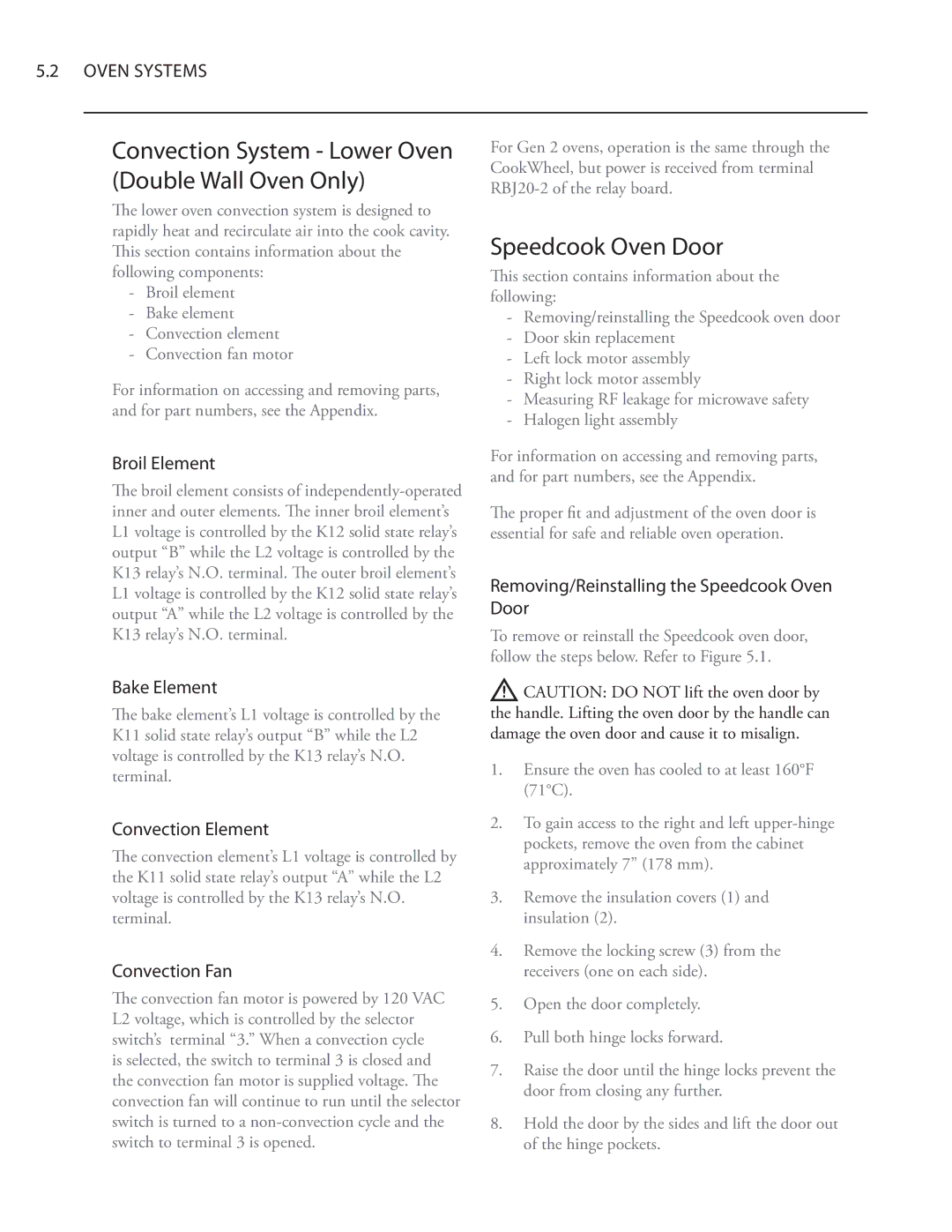5.2OVEN SYSTEMS
Convection System - Lower Oven | For Gen 2 ovens, operation is the same through the | ||
(Double Wall Oven Only) | CookWheel, but power is received from terminal | ||
The lower oven convection system is designed to |
| ||
rapidly heat and recirculate air into the cook cavity. | Speedcook Oven Door | ||
This section contains information about the | |||
following components: | This section contains information about the | ||
- | Broil element | following: | |
- | Bake element | - Removing/reinstalling the Speedcook oven door | |
- | Convection element | - Door skin replacement | |
- | Convection fan motor | - Left lock motor assembly | |
For information on accessing and removing parts, | - Right lock motor assembly | ||
- Measuring RF leakage for microwave safety | |||
and for part numbers, see the Appendix. | |||
- Halogen light assembly | |||
|
| ||
Broil Element | For information on accessing and removing parts, | ||
and for part numbers, see the Appendix. | |||
The broil element consists of | |||
| |||
inner and outer elements. The inner broil element’s | The proper fit and adjustment of the oven door is | ||
L1 voltage is controlled by the K12 solid state relay’s | essential for safe and reliable oven operation. | ||
output “B” while the L2 voltage is controlled by the |
| ||
K13 relay’s N.O. terminal. The outer broil element’s | Removing/Reinstalling the Speedcook Oven | ||
L1 voltage is controlled by the K12 solid state relay’s | |||
Door | |||
output “A” while the L2 voltage is controlled by the | |||
| |||
K13 relay’s N.O. terminal. | To remove or reinstall the Speedcook oven door, | ||
|
| follow the steps below. Refer to Figure 5.1. | |
Bake Element
The bake element’s L1 voltage is controlled by the K11 solid state relay’s output “B” while the L2 voltage is controlled by the K13 relay’s N.O. terminal.
Convection Element
The convection element’s L1 voltage is controlled by the K11 solid state relay’s output “A” while the L2 voltage is controlled by the K13 relay’s N.O. terminal.
Convection Fan
The convection fan motor is powered by 120 VAC L2 voltage, which is controlled by the selector switch’s terminal “3.” When a convection cycle is selected, the switch to terminal 3 is closed and the convection fan motor is supplied voltage. The convection fan will continue to run until the selector switch is turned to a
![]() CAUTION: DO NOT lift the oven door by the handle. Lifting the oven door by the handle can damage the oven door and cause it to misalign.
CAUTION: DO NOT lift the oven door by the handle. Lifting the oven door by the handle can damage the oven door and cause it to misalign.
1.Ensure the oven has cooled to at least 160°F (71°C).
2.To gain access to the right and left
3.Remove the insulation covers (1) and insulation (2).
4.Remove the locking screw (3) from the receivers (one on each side).
5.Open the door completely.
6.Pull both hinge locks forward.
7.Raise the door until the hinge locks prevent the door from closing any further.
8.Hold the door by the sides and lift the door out of the hinge pockets.
